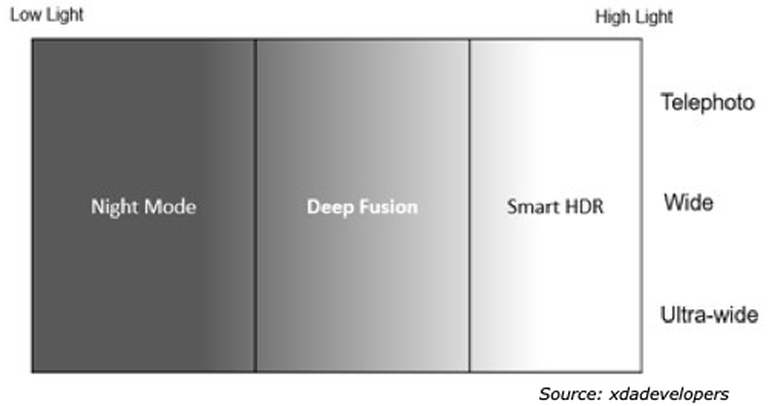Vertical Divider
iPhone 12 Inspires New Smartphone Trends
Apple jumped on board the 5G bandwagon and it should spur interest around the world, even as the rollout in the US is slow and the use miniscule. But there are several other changes Apple has made with the iPhone 12 series that could be trendy in 2021.
Figure 1: iPhone 12 Mini
Apple jumped on board the 5G bandwagon and it should spur interest around the world, even as the rollout in the US is slow and the use miniscule. But there are several other changes Apple has made with the iPhone 12 series that could be trendy in 2021.
- No charger in the box -- When Apple removed the century-old headphone jack from the iPhone 7 in 2016, it led to backlash from consumers and media. Rival smartphone brands even took jabs at Apple for it. But ultimately, Apple had its way, and now virtually all Android flagships — including those from brands that initially poked fun at the idea — don’t have the 3.5mm jack. Apple claims it’s an effort to reduce e-waste, but the charger is different from previous iPhones, so a new one is still required. Samsung is already considering the move although Samsung, OnePlus, and ASUS have already posted ads mocking Apple for its decision, but how long will it be before they do the same?
- Mini sized flagships -- The iPhone 12 Mini is really small as shown below. Despite its petite size (131.5 x 64.2 x 7.4mm), the iPhone 12 Mini is not lacking in power, using the same 5nm A14 Bionic SoC as its bigger brothers. Its 5.4-inch screen is an FHD AMOLED panel, too. It’s a flagship phone in a compact size. The Samsung Galaxy Note 20 Ultra, for example, has a 6.9-inch display and measures 164.8 x 77.2 x 8.1 mm. The OnePlus 8 Pro has a 6.8-inch screen and measures 165.3 x 74.4 x 8.5 mm.
Figure 1: iPhone 12 Mini
- Dolby Vision for HDR – Dolby Vision encodes data dynamically in real-time, and these data instructs the video to adjust color and temperature and exposure as the scene shifts. HDR 10+ receives only static metadata, meaning whatever enhancements are made to the video is a one-time application and applies for the entire video without accounting for shifts in lighting condition. There are other advantages to Dolby Vision, as RTINGS points out. Dolby vision requires a bleeding-edge SoC to handle all that processing in real time. Of the available Qualcomm Snapdragon SoCs, only the Snapdragon 865 currently supports video capture in Dolby Vision. More importantly, it costs money to license the encoding tech from Dolby. However, if big Android brands like Samsung and Huawei want to compete, they’ll likely have to jump on the Dolby Vision train too.
- LiDAR sensor for better AR -- There are AR apps in Android, but they pale in comparison to iPhones and iPad apps. Apple is improving the apps by introducing the LiDAR (Light Detection and Ranging) sensor from this year’s iPad Pros, to the iPhone 12 Pro and 12 Pro Max. LiDAR is like the TOF (time-of-flight) sensor that some Android phones have used, in that they both shoot beams to create a radar effect to “map” an area and objects in it. Recent iOS devices, are arguably the most practical reason to justify AR’s existence — it allows users to measure things in the real world using their smartphone or tablet. Android’s Measure app and a third-party-app named ARuler, neither could correctly identify a TV in a room. For AR to grow, third-party app makers need to step up. Now that the iPhone 12 Pro and Pro Max have LIDAR scanners in them, that gives third-party app makers plenty of incentive to build AR apps. If Android phones want in, they’ll have to do a bit better than 2MP depth sensors.
- Deep Fusion is an advanced image processing system that improves texture, detail with reduced noise in lower light. The technology was only available on the wide and telephoto lenses of the iPhone 11 Pros. But now with the support of the A14 Bionic chip, Deep Fusion has been extended to the ultra-wide and selfie cameras of the iPhone 12 Pros. Users now can expect more true-to-life images, especially in low-light scenes.
Figure 2: Deep Fusion Comes to Ultra-wide Camera
- Upgrade to 7P Lens From 6P Lens-- the iPhone 12 Pros feature a new 7P lens for the wide camera, a significant improvement compared to the iPhone 11 Pros’ 6P lens. The 7P design allows for a larger aperture, making it possible for iPhone 12 Pros’ wide camera to offer a f/1.6 aperture, an improvement from the f/1.8 aperture of the iPhone 11 Pros. It increases the lens’ light-gathering ability by 27%, enabling faster shutter speeds or less grainy ISO settings in low light. Often, compromises are made in terms of sharpness and performance when designing lenses with larger apertures, but the new 7P structure maintains sharp detail in a photo from edge to edge.
|
Contact Us
|
Barry Young
|


